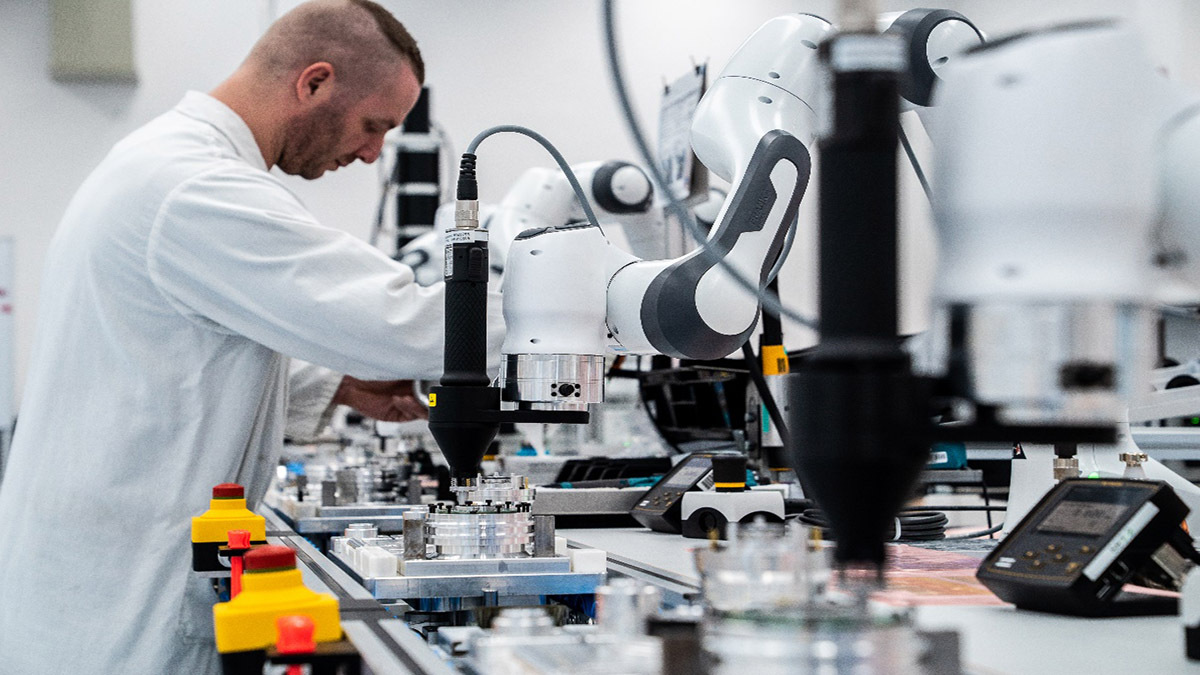Power tools to the people: making robotics accessible to everyone
Sponsored by Franka Emika
Over the past decades there’s been a dramatic reduction in manufacturing across Europe, as the western European cost structure in particular struggles to compete with international low-income labour. Companies must outsource their manufacturing to low-income countries or shut down entirely. Robotics, however, makes it possible to relieve people of unnecessary labour, increase productivity and drive revenue. Combining highly qualified factory workers with low-cost automation enables them to compete with low-income manual labour. New generation robotics can handle short production cycles, and those that require lots of minor adjustments. But even today, robotics technology remains a luxury for all but the largest multinationals and confined to a narrow range of industries. The most obvious and prevalent example is the automotive industry, although even here robotics has seen little development for decades. In-deed, robotics technology has seen little improvement overall, focusing on solutions that are remote from humans, costly, specialised and inflexible. These systems require not only six-figure investments, but also many weeks to be set up and programmed. Demanding extensive knowledge in the field, they allow for little flexibility in adjusting and re programming tasks, making the return-on-investment very high. Franka Emika’s vision is to make robotics accessible to everyone. Our robotic assistants are affordable, as usable as a smartphone, and are designed for direct human-robot interaction while equipped with the highest capabilities. Our users from highly skilled robotics professionals to factory workers in firms of all sizes – are benefiting from this easy-to-use, flexible, cost-efficient and scalable approach. Our revolutionary robotic system Panda has been specially designed to be deployed within the 3C (computer, communication and consumer electronics) industry. However, it is capable of automating various tasks within any given sector, relieving factory workers of tiresome, repetitive and potentially even dangerous tasks, therefore relocating human resources towards more engaging and impactful assignments. Plug-and-play robotics As mentioned before, robotics has been stagnating for decades. But the industry is now at a stage comparable to the introduction of PCs, smartphones and the internet. Our robot systems can be used by everyone, with no need for specific know-how or integration methods. The future is already here. The plug-and-play or “out of the box” – approach is at the core of Franka Emika’s methodology and design. Panda offers the easiest and fastest set-up – in under 15 minutes it easily integrates into any environment. It can be operated through any PC or mobile device and can be used by laymen or experts alike. Panda is the first system that can be operated via smartphone-like apps, with an engaging, intuitive dialogue menu. It can learn new tasks in minutes by direct interaction, such as hand-guiding. Apps and tasks can be easily purchased and/or shared through our novel digital robotics platform Franka World. Users can reuse or deploy taught tasks on multiple robots to reduce costs and increase profit significantly. It is a unique, powerful tool, and the first of its kind. Panda offers human-like agility thanks to a full seven axes of movement, and has an inherent, even adaptive compliance with novel sensor technology, algorithms and machine learning. Panda is not only revolutionary, it’s also affordable. At less than €11,000 it is considerably less expensive than other players on the market, and can be equipped with apps and services through Franka World. Are robots truly compatible with human employees? Our team was among the researchers who invented physical human-robot interaction more than a decade ago. Most robots avail able on the market are pre-programmed positioning machines. We, however, see robots as power tools that serve humans and make their lives easier. More than 15 years of research made this concept possible, but as with any technological revolution, it takes time for it to be fully embraced by the market and the general population. Panda represents a new generation of sensitive and versatile power tools with a unique sense of touch that supports humans in various tasks. It has shifted the perspective on robots from being dangerous job-killers to interactive devices comparable to smartphones. Industrial robotics still requires a lot of safety regulation, predominantly the legacy of the metal giants of classical industrial robotics. But you can use our robots with minimised safety guards and in a collaborative way – the specifics depend on the application, the end-effectors, the level of trained personnel and other factors. However, we are on the verge of dramatic changes. It is just a matter of time when cyber-physical systems – devices that connect the digital with the real world – including robotics, drones and autonomous vehicles will be deployed in huge numbers. Besides technological hurdles – mainly the visual perception – the biggest challenges will and should be the acceptance of the general population, as well as legal and liability issues. Europe is the technology leader in this field, but we are far behind when it comes to educating the population and setting up clear rules. This could be factor which will lose us the next battle in technology and become purely a bystander, as happened in the smart device era. Is RaaS the most effective approach to SME robotics adoption? SMEs seek the simplest available solutions that allow for maximum flexibility and scalability. Most people are familiar with using technology, especially software, as a service (SaaS), and therefore RaaS definitely has great potential. However, one must differentiate between the entire robot system as a service, which requires a certain logistical effort, and using robot functionalities as a service. For the first time, the latter is possible with Panda’s industrial-suited robot system. Franka World, the revolutionary platform we launched at this year’s Hannover Messe, enables community interaction between researchers, partners, customers, developers, suppliers and even robots themselves, to push the frontiers of Industry 4.0. Besides communication, everyone is able to easily gain integrated access to products, services and management of entire robot fleets, independent of their physical location. Consequently, RaaS is an inherent part of our business model, and it will follow a similar success story as, for example, when expensive on-premises solutions were supplanted by enterprise resource planning (ERP) systems. We strive for a world where everyone can use a robot, and we can reach that by connecting the world.
For more information, please visit www.franka.de

Business Reporter Team
Related Articles
Most Viewed
Winston House, 3rd Floor, Units 306-309, 2-4 Dollis Park, London, N3 1HF
23-29 Hendon Lane, London, N3 1RT
020 8349 4363
© 2025, Lyonsdown Limited. Business Reporter® is a registered trademark of Lyonsdown Ltd. VAT registration number: 830519543





